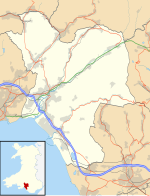Margam Stones Museum
 |
|
| Established | 1892 (1932 in current building) |
|---|---|
| Location | SS80078632, Port Talbot, South Wales, SA13 2TA |
| Coordinates | 51°33′48″N 3°43′50″W / 51.56327°N 3.73057°W |
| Type | Museum of early Christian carved stones |
| Curator | Cadw |
| Nearest car park | On site (free) |
| Website | cadw |
Margam Stones Museum is a small Victorian schoolhouse near Port Talbot, South Wales, which now provides a home for one of the most important collections of Celtic stone crosses in Britain. All originally found within the locality of Margam, and mostly assembled as a collection in the 19th century, they provide enduring testimony to a Welsh Christian culture between the 6th and 16th centuries. The striking Cross of Conbelin is the most celebrated example. From around 1000 AD, it is a huge disc cross with Celtic interlace and plaitwork patterns, figurative scenes including a hunting scene, and inscriptions telling us who made it and who erected it. There are 17 early Christian stones, plus 11 memorials and other stones from the post-Norman periods. The museum is run by Cadw, the Welsh historic sites agency, and is close to Margam Abbey Church and the ruins of the Abbey buildings.
Postcode: SA13 2TA. Access road is just north of J38 of the M4, 4 miles (6.4 km) south-east of Port Talbot. There is a car park for visitors to the Abbey, Museum and Abbots Kitchen Restaurant.
Margam Abbey was a Cistercian Abbey founded in 1147, and the nave survives as Margam Parish Church. Upon its dissolution in 1536 the Mansel family acquired it, and built a mansion in the grounds. In 1786 it passed by marriage to the Talbot family of Lacock, Wiltshire, and it is they, during the 19th century, who began to gather together various stone crosses and standing stones in the locality. Initially they were placed in the mansion grounds. In 1892 Emily Talbot gave them to the nation, in the care of the Commissioner of Public Works. In 1932 they were moved into their present building, a former Church schoolhouse close to Margam Abbey Church. Other stones from the Abbey and the local area were added to the collection, which is now in the care of Cadw.
Of the 30 or so ancient carved stones in the museum, 17 are pre-Norman, and are displayed on the ground floor. The remainder are Margam Abbey memorials, housed in the upper gallery, and are mainly tomb slabs. They include Cistercian and post-reformation memorials.
...
Wikipedia

